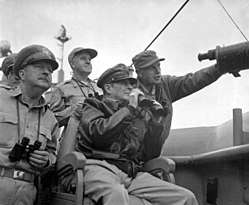Courtney Whitney
| Courtney Whitney | |
|---|---|
 Whitney, at left holding binoculars, with MacArthur, seated center, observing the shelling of Incheon, Korea | |
| Born |
20 May 1897 Washington, D.C., U.S. |
| Died | 21 March 1969 (aged 71) |
| Buried | Arlington National Cemetery |
| Allegiance |
|
| Service/ |
|
| Rank |
|
| Battles/wars |
World War I World War II Korean War |
| Awards |
Distinguished Service Medal Silver Star Legion of Merit (2) |
| Other work | Lawyer |
Major General Courtney Whitney (May 20, 1897 - March 21, 1969) was a lawyer and US Army commander during World War II who later served as a senior official during the US occupation of Japan (1945-1951). He played a major role in the liberalization of Japanese government, society, and economy during the occupation.
Early life
Born in Washington, DC, Whitney enlisted in the US Army in 1917 and became a pursuit pilot. He received his law degree from George Washington University in 1927 and left the army to open a private practice in Manila.
World War II
In 1940, Whitney returned to active duty. He worked in intelligence in Washington, DC, and was assigned to serve as the intelligence officer to the 14th Air Force in China when General Douglas MacArthur requested for him to be assigned to the Southwest Pacific Theater. Whitney returned to Leyte Gulf alongside MacArthur in 1944.[1]
In his biography of MacArthur, William Manchester states that Lieutenant Colonel Whitney, a "ultraconservative Manila corporation lawyer," was assigned to MacArthur's staff, promoted, and assigned responsibility for Philippine civil affairs.[2] Manchester states:
from the standpoint of the guerrillas he was a disastrous choice. Undiplomatic and belligerent, he was condescending toward all Filipinos, except those who, like himself, had substantial investments in the Philippines... and by the time MacArthur was ready to land on Leyte, Whitney had converted most of the staff to reactionaryism. At his urging the General (MacArthur) barred OSS agents from the Southwest Pacific, because Whitney suspected they would aid leftwing guerrillas.[2]
Occupation of Japan
After Japan surrendered, Whitney accompanied MacArthur to Atsugi Air Base and became Chief of the Government Section at GHQ. With Lt. Col. Milo Rowell, he drafted the Constitution of Japan and sent it to the Diet for approval. Historians emphasize the similarity of occupation policies to the US New Deal programs of the 1930s.[3] Moore and Robinson note that "New Deal liberalism seemed natural, even to conservative Republicans such as MacArthur and Whitney."[4]
Whitney remained close to MacArthur throughout the occupation and served, alongside MacArthur, during the Korean War. He resigned from the army after MacArthur was removed from command in 1951. In 1956, Whitney's biography of his commander, MacArthur: His Rendezvous With History, was published.
Legacy
Whitney is buried at Arlington National Cemetery.
In popular culture
Whitney was played by Dick O'Neill in the 1977 film MacArthur
References
- ↑ Dunn, William J. (2009-09). "Pacific Microphone". Texas A&M University Press. ISBN 9781603441575. Retrieved 27 September 2014. Check date values in:
|date=(help) - 1 2 Manchester W. American Caesar. 1978. pp 378-379.
- ↑ Theodore Cohen and Herbert Passin, Remaking Japan: The American Occupation as New Deal (1987)
- ↑ Ray A. Moore and Donald L. Robinson, Partners for democracy: Crafting the new Japanese state under Macarthur (Oxford University Press, 2004) p 98
Bibliography
- James, D. Clayton. The Years of MacArthur 1941-45 (Boston: Houghton Mifflin, 1975), vol 2
- James, D. Clayton. The years of MacArthur: Triumph and disaster, 1945-1964 (Boston: Houghton Mifflin, 1985), vol 3
- Manchester, W. 1978. American Caesar: Douglas MacArthur 1880-1964. Little, Brown and Company, Boston. ISBN 0-316-54498-1
- Whitney, Courtney. MacArthur: His Rendezvous with Destiny (New York: Alfred E. Knopf 1956)
- Williams, Justin. "Completing Japan's Political Reorientation, 1947-1952: Crucial Phase of the Allied Occupation." American Historical Review (1968): 1454-1469. in JSTOR